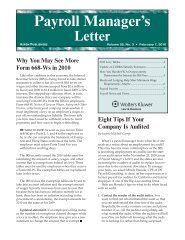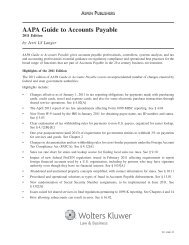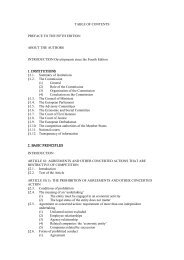journal of pension planning & compliance - Kluwer Law International
journal of pension planning & compliance - Kluwer Law International
journal of pension planning & compliance - Kluwer Law International
You also want an ePaper? Increase the reach of your titles
YUMPU automatically turns print PDFs into web optimized ePapers that Google loves.
26 / JOURNAL OF PENSION PLANNING & COMPLIANCE<br />
participants in fiduciary litigation. 68 The plan administrator, which was<br />
also the plan sponsor, had claimed that the fiduciary exception to the<br />
attorney-client privilege applied only to matters where the administrator<br />
was acting in its capacity as plan administrator, not to matters where<br />
it was acting in its capacity as plan sponsor, and that as a result, the<br />
district court should have examined all the documents before ordering<br />
production to determine which ones related to fiduciary functions and<br />
which ones to settlor functions. The Fifth Circuit concluded, however,<br />
that even if some <strong>of</strong> the documents concerned matters for which the<br />
company was acting as plan sponsor, the participants could obtain<br />
the documents upon a showing <strong>of</strong> good cause under the exception to<br />
the attorney-client privilege afforded to shareholders <strong>of</strong> a corporation<br />
in suits against the corporation’s board <strong>of</strong> directors. 69<br />
In a case brought in the Second Circuit, a magistrate judge also<br />
found that ESOP participants could be viewed as indirect stockholders<br />
in a derivative suit and, as such, could obtain access under Garner<br />
to otherwise privileged communications. 70 In that case, two ESOP<br />
participants had sued multiple defendants, alleging that the ESOP purchased<br />
overvalued employer stock. The judge rejected the defendants’<br />
claim that the number <strong>of</strong> participants who had sued was inadequate<br />
to establish good cause for disclosure, explaining that the ESOP the<br />
participants represented owned 30% <strong>of</strong> the company’s stock and that,<br />
in any event, the most important consideration in the Garner analysis is<br />
that there be a fiduciary relationship, which the court found to exist by<br />
virtue <strong>of</strong> the derivative suit. 71<br />
In a third case, a district court in the Fifth Circuit also acknowledged<br />
the applicability <strong>of</strong> the Garner doctrine where plan participants<br />
are stockholders <strong>of</strong> a company, at least indirectly through their interest<br />
in an ESOP. In that case, however, the court found that the participants<br />
had not satisfied the requirement in Garner that good cause be shown<br />
for overcoming the company’s attorney-client privilege. The court noted<br />
that: (1) according to their ESOP account balances, the number <strong>of</strong><br />
shares <strong>of</strong> company stock attributable to the participants who had sued<br />
equaled less than 5,000 out <strong>of</strong> approximately 14 million shares <strong>of</strong> outstanding<br />
stock; (2) two <strong>of</strong> the participants displayed a history <strong>of</strong> personal<br />
animosity and grudges against the defendants; (3) the participants<br />
could find out what they needed to know about the fiduciaries’ motives<br />
through depositions and discovery without the privileged information;<br />
and (4) the participants’ requests were extremely broad. 72<br />
Cases Where Good Cause Was Not Required<br />
Another theory for recognizing an exception to the attorney-client<br />
privilege in fiduciary litigation was advanced in Washington-Baltimore






